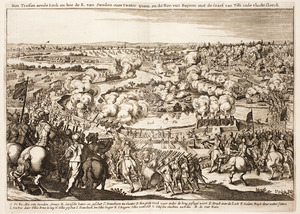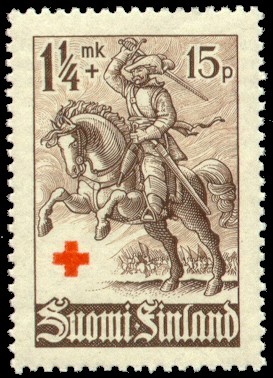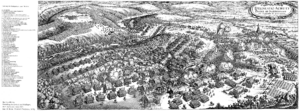Hakkapeliitta facts for kids

The Hakkapeliitta (in Finnish, plural hakkapeliitat) was a special kind of Finnish light cavalry soldier. These soldiers served King Gustavus Adolphus of Sweden. They were very important during the Thirty Years' War, which lasted from 1618 to 1648.
The name "Hakkapeliitta" comes from a Finnish battle cry. This cry was hakkaa päälle, which means "strike upon them!" or "Cut them down!" Foreigners in the Holy Roman Empire heard this cry. They started calling these soldiers by names like Hackapelit or Hackapelite. The Finnish name "Hakkapeliitta" came later, in the 1800s.
These brave cavalry soldiers first appeared in wars between Poland and Sweden in the late 1500s. In the early 1600s, Hakkapeliitta cavalry fought in campaigns against Poland and Russia. Later, during the Thirty Years' War, they helped Sweden win many battles in Germany. Field Marshal Gustaf Horn led many of these important cavalry units.
The Finnish military march Hakkapeliittain Marssi is named after these famous soldiers.
How Hakkapeliitta Fought
The Hakkapeliitta were very skilled Finnish light cavalrymen. They were excellent at quick attacks, raiding, and finding out what the enemy was doing (reconnaissance). They were also great in big battles. Their biggest advantage was how fast and fiercely they could charge at the enemy.
These horsemen did not wear heavy armor. They had a broadsword and two wheellock pistols. For protection, they wore a thick leather coat called a buff coat and a pot helmet on their heads. Sometimes, they also wore a steel breastplate to protect their chest.
When they attacked, they would ride at a full gallop. The soldiers in the front would fire their pistols very close to the enemy. Then, the whole group would crash into the enemy lines with their swords. Their horses were also a weapon. They would use the horses to trample enemy infantrymen (foot soldiers).
The horses ridden by the Hakkapeliitta were strong and tough. They were the ancestors of today's modern Finnhorse breed.
How They Were Organized
The Swedish army had three main cavalry regiments from Finland:
- Nyland and Tavastehus County Cavalry Regiment (in Swedish: Nylands och Tavastehus läns kavalleriregemente)
- Åbo and Björneborg County Cavalry Regiment (Åbo och Björneborgs läns kavalleriregemente)
- Viborg and Nyslott County Cavalry Regiment (Viborgs och Nyslotts läns kavalleriregemente)
Their most famous leader was Torsten Stålhandske. His last name means "steelglove." He became a lieutenant-colonel in 1629 and led the Nyland and Tavastehus Cavalry Regiment in the Thirty Years' War.
These regiments were part of a bigger military plan. King Gustavus Adolphus created 21 infantry and eight cavalry regiments in the 1610s. This organization was written into the Swedish constitution of 1634.
Important Battles

The Hakkapeliitta fought in many important battles during the Thirty Years' War. Here are some of them:
- Breitenfeld in 1631
- Lech in 1632
- Battle of Alte Veste in 1632
- Lützen in 1632
- Nördlingen in 1634
- Leipzig in 1642 (also known as the Second Battle of Breitenfeld)
- Jankau in 1645
In 1658, 200 Hakkapeliitta soldiers were part of King Karl X Gustav of Sweden's army. This army marched across the frozen Danish straits in winter. This amazing feat helped Sweden take Skåneland from Denmark in the Treaty of Roskilde.
Many Finnish soldiers served the Swedish Empire during the 1600s. The Finnish cavalry often fought in places like Germany, Bohemia, Poland, and Denmark. Some cavalry units were also stationed in Estonia and Livonia.
See also
 In Spanish: Hakkapeliitta para niños
In Spanish: Hakkapeliitta para niños



